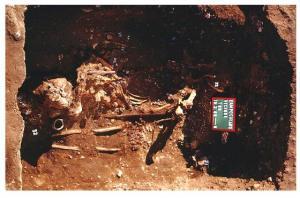The Cemetery of the Barbarian Warriors
Kathryn M. Meyers
Source - http://www.bonesdontlie.com/
A recent article by Rubini and Zaio (2011) makes this process of elimination explicit in their analysis of cemetery from central Italy. Given a lack of direct evidence to a settlement, understanding the context of the cemetery and the roles of the people within it is slightly more complex, and requires close attention to the evidence.
The cemetery under investigation is is known as Campochiaro, and is located in Molise. It dates from the 6th to 8th centuries CE, and consists of two primary burial areas: Morrione and Vicenne, although only the former was investigated further in this analysis. While there is no known settlement attached to the burial site, this lack of settlement suggests that the population was semi-nomadic. Further, there are abundant artifacts which argue for the site to be part of a multi-cultural barbarian population. The artifacts can be attributed to the Lombards, Avars, and a number of nomadic Asian populations. This is further supported by the variation in grave goods, and burial layouts. In this time period, central Italy was the site of territory conflict between the Lombards and the Byzantine army. Therefore, Rubini and Zaio (2011) argue that the individuals in the Campochiaro area may have been part of a military outpost built to protect and control the border.

Rubini and Zaio 2011
At the Morrilone cemetery, there were 234 graves were excavated. Of these, a few were selected for deeper investigation due to paleopathology. Grave 20 contained an older male, over 55 years. He was about 161 cm with mongoloid facial characteristics. He also had very pronounced muscle markers on his skeleton, which suggest he was engaged in activities like drawing a bow and riding a horse. He has a blunt force injury on the side of his skull at the parietal. The wound is healed, and has signs of medical treatment. This is typical of Avar warriors who were both fierce and good with medicine. Grave 102 also contained an older male, aged 50-55 years. He was 169 cm tall and had Adriatic facial characteristics. On his skull there was a healed slice through orbit and frontal bone suggesting sharp force trauma.
Grave 108, like the others, was an old male older than 50 years. He was 161 cm tall and his facial features were not clearly one type of ethnicity. He had a number of pathologies, including osteoarthritis in the spine and sharp force trauma to the fontal bone. He also had destruction of the facial bones and bony resorption of the nasal bones usually associated with rhinomaxillary syndrome and leprosy. There was also leprous destruction in the hands and feet. The disease would have been highly disabling due to loss of feeling and control in the appendages. However, there are stories of leprous barbarian kings battling through both foreigners despite their disease.
Injuries by all are clearly related to conflict and not due to accident. This was determined by the authors due to the pattern of the injuries. The combination of blunt and sharp force trauma around the head is suggestive of warfare. This is further supported by the high number of weapons found in the graves, and the location. This evidence, combined with location and ethnic identity supports the author’s conclusion that this burial site belonged to a nomadic group on the borders of the Byzantine/Lombard-Avar lines.
What I like about this article was that the authors had an interpretation of the site as a warrior cemetery, and then went through each piece of evidence to show how they arrived at this conclusion. However, I’d like to know more about the entire cemetery and the rest of the population. We are given only a small snap shot of what the population contains, and it isn’t even a representative one. The sample contains individuals who are extremely similar, so we don’t know if they are good representations of the entire population. Knowing the age and sex distribution is important towards interpreting the site as a whole. Hopefully future articles will explore the site more fully.
Works Cited
Rubini and Zaio (2011). Warrior from the East: Skeletal eivdence of warfare from a Lonbard-Avar cemetery in Central Italy. In Journal of Archaeological Science 38.
